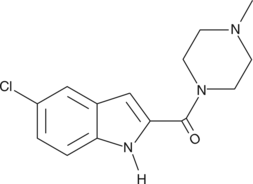Chemicals
Showing 23251–23400 of 41137 results
-
JNJ-40418677 is a modulator of γ-secretase.{46387} It reduces the levels of amyloid-β (1-42) (Aβ42; Item No. 20574) in a cell-free γ-secretase modulation assay. It also reduces the secretion of Aβ42, but not total Aβ, in SK-N-BE(2) human neuroblastoma cells expressing amyloid precursor protein (APP; mean IC50 = 200 nM) and in primary rat cortical neurons (mean IC50 = 185 nM). JNJ-40418677 (100 and 300 mg/kg) reduces the level of Aβ42 in wild-type mouse brain. It decreases brain levels of Aβ42, Aβ40, and Aβ38 in the deposited fraction, and Aβ42 and Aβ40 in the soluble fraction, in the Tg2576 mouse model of Alzheimer’s disease when administered at doses of 60 and 120 mg/kg per day in the diet for seven months. It also reduces increases in the number of amyloid plaques in Tg2576 mouse brain compared to vehicle control animals.
Brand:CaymanSKU:21869 -Out of stock
JNJ-40418677 is a modulator of γ-secretase.{46387} It reduces the levels of amyloid-β (1-42) (Aβ42; Item No. 20574) in a cell-free γ-secretase modulation assay. It also reduces the secretion of Aβ42, but not total Aβ, in SK-N-BE(2) human neuroblastoma cells expressing amyloid precursor protein (APP; mean IC50 = 200 nM) and in primary rat cortical neurons (mean IC50 = 185 nM). JNJ-40418677 (100 and 300 mg/kg) reduces the level of Aβ42 in wild-type mouse brain. It decreases brain levels of Aβ42, Aβ40, and Aβ38 in the deposited fraction, and Aβ42 and Aβ40 in the soluble fraction, in the Tg2576 mouse model of Alzheimer’s disease when administered at doses of 60 and 120 mg/kg per day in the diet for seven months. It also reduces increases in the number of amyloid plaques in Tg2576 mouse brain compared to vehicle control animals.
Brand:CaymanSKU:21869 -Out of stock
Hypoxia-inducible factor (HIF) prolyl hydroxylase (PHD) enzymes act as central gatekeepers of posttranscriptional and transcriptional adaptation to hypoxia, oxidative stress, and excitotoxicity. Their catalytic activity is dependent on iron, 2-oxoglutarate (2-OG), and oxygen, and leads to the stabilization of a host of proteins, including the hypoxia-inducible transcription factors in response to oxygen availability.{29642} Inhibitors of PHD have been used to mimic a hypoxic response in order to study a range of oxygen-deprivation-related disorders, including anemia, ulcerative colitis, myocardial ischemia, stroke, and metabolic disorders. JNJ-42041935 is a selective, 2-OG competitive, and reversible inhibitor of PHD enzymes (pKis = 7.91, 7.29, and 7.65 for PHD1, 2, and 3, respectively).{29641} It is >100-fold selective for PHD compared to the related FIH (factor-inhibiting HIF) and a panel of various other enzymes.{29641} In an inflammation-induced anemia model in rats, 100 µM/kg/day JNJ-42041935 significantly increased the number of circulating reticulocytes and red blood cells, increased blood hemoglobin and hematocrit, and restored mean corpuscular volume and mean cell hemoglobin of red bloods cells.{29641}
Brand:CaymanSKU:-Hypoxia-inducible factor (HIF) prolyl hydroxylase (PHD) enzymes act as central gatekeepers of posttranscriptional and transcriptional adaptation to hypoxia, oxidative stress, and excitotoxicity. Their catalytic activity is dependent on iron, 2-oxoglutarate (2-OG), and oxygen, and leads to the stabilization of a host of proteins, including the hypoxia-inducible transcription factors in response to oxygen availability.{29642} Inhibitors of PHD have been used to mimic a hypoxic response in order to study a range of oxygen-deprivation-related disorders, including anemia, ulcerative colitis, myocardial ischemia, stroke, and metabolic disorders. JNJ-42041935 is a selective, 2-OG competitive, and reversible inhibitor of PHD enzymes (pKis = 7.91, 7.29, and 7.65 for PHD1, 2, and 3, respectively).{29641} It is >100-fold selective for PHD compared to the related FIH (factor-inhibiting HIF) and a panel of various other enzymes.{29641} In an inflammation-induced anemia model in rats, 100 µM/kg/day JNJ-42041935 significantly increased the number of circulating reticulocytes and red blood cells, increased blood hemoglobin and hematocrit, and restored mean corpuscular volume and mean cell hemoglobin of red bloods cells.{29641}
Brand:CaymanSKU:-Hypoxia-inducible factor (HIF) prolyl hydroxylase (PHD) enzymes act as central gatekeepers of posttranscriptional and transcriptional adaptation to hypoxia, oxidative stress, and excitotoxicity. Their catalytic activity is dependent on iron, 2-oxoglutarate (2-OG), and oxygen, and leads to the stabilization of a host of proteins, including the hypoxia-inducible transcription factors in response to oxygen availability.{29642} Inhibitors of PHD have been used to mimic a hypoxic response in order to study a range of oxygen-deprivation-related disorders, including anemia, ulcerative colitis, myocardial ischemia, stroke, and metabolic disorders. JNJ-42041935 is a selective, 2-OG competitive, and reversible inhibitor of PHD enzymes (pKis = 7.91, 7.29, and 7.65 for PHD1, 2, and 3, respectively).{29641} It is >100-fold selective for PHD compared to the related FIH (factor-inhibiting HIF) and a panel of various other enzymes.{29641} In an inflammation-induced anemia model in rats, 100 µM/kg/day JNJ-42041935 significantly increased the number of circulating reticulocytes and red blood cells, increased blood hemoglobin and hematocrit, and restored mean corpuscular volume and mean cell hemoglobin of red bloods cells.{29641}
Brand:CaymanSKU:-JNJ-42153605 is a positive allosteric modulator of metabotropic glutamate receptor 2 (mGluR2; EC50 = 17 nM in CHO cells expressing the human receptor).{48351} In vivo, JNJ-42153605 (3 mg/kg) inhibits mGluR2-mediated rapid eye movement (REM) sleep in rats. It also reverses phencyclidine-induced hyperlocomotion in mice (ED50 = 5.4 mg/kg).
Brand:CaymanSKU:21984 -Out of stock
JNJ-42153605 is a positive allosteric modulator of metabotropic glutamate receptor 2 (mGluR2; EC50 = 17 nM in CHO cells expressing the human receptor).{48351} In vivo, JNJ-42153605 (3 mg/kg) inhibits mGluR2-mediated rapid eye movement (REM) sleep in rats. It also reverses phencyclidine-induced hyperlocomotion in mice (ED50 = 5.4 mg/kg).
Brand:CaymanSKU:21984 -Out of stock
JNJ-42153605 is a positive allosteric modulator of metabotropic glutamate receptor 2 (mGluR2; EC50 = 17 nM in CHO cells expressing the human receptor).{48351} In vivo, JNJ-42153605 (3 mg/kg) inhibits mGluR2-mediated rapid eye movement (REM) sleep in rats. It also reverses phencyclidine-induced hyperlocomotion in mice (ED50 = 5.4 mg/kg).
Brand:CaymanSKU:21984 -Out of stock
JNJ-42153605 is a positive allosteric modulator of metabotropic glutamate receptor 2 (mGluR2; EC50 = 17 nM in CHO cells expressing the human receptor).{48351} In vivo, JNJ-42153605 (3 mg/kg) inhibits mGluR2-mediated rapid eye movement (REM) sleep in rats. It also reverses phencyclidine-induced hyperlocomotion in mice (ED50 = 5.4 mg/kg).
Brand:CaymanSKU:21984 -Out of stock
JNJ-42165279 is a potent, irreversible inhibitor of fatty acid amide hydrolase (FAAH; IC50s = 70 and 313 nM for human and rat forms, respectively).{32207} It displays selectivity for FAAH over a panel of other enzymes, receptors, transporters, and ion channels. JNJ-42165279 is active in vivo, blocking FAAH activity in brain and periphery of rats and raising concentrations of anandamide (Item No. 90050), oleoyl ethanolamide (Item No. 90265), and palmitoyl ethanolamide (Item No. 90350).{32207} It is also efficacious in the spinal nerve ligation model of neuropathic pain.{32207}
Brand:CaymanSKU:19987 -Available on backorder
JNJ-42165279 is a potent, irreversible inhibitor of fatty acid amide hydrolase (FAAH; IC50s = 70 and 313 nM for human and rat forms, respectively).{32207} It displays selectivity for FAAH over a panel of other enzymes, receptors, transporters, and ion channels. JNJ-42165279 is active in vivo, blocking FAAH activity in brain and periphery of rats and raising concentrations of anandamide (Item No. 90050), oleoyl ethanolamide (Item No. 90265), and palmitoyl ethanolamide (Item No. 90350).{32207} It is also efficacious in the spinal nerve ligation model of neuropathic pain.{32207}
Brand:CaymanSKU:19987 -Available on backorder
JNJ-42165279 is a potent, irreversible inhibitor of fatty acid amide hydrolase (FAAH; IC50s = 70 and 313 nM for human and rat forms, respectively).{32207} It displays selectivity for FAAH over a panel of other enzymes, receptors, transporters, and ion channels. JNJ-42165279 is active in vivo, blocking FAAH activity in brain and periphery of rats and raising concentrations of anandamide (Item No. 90050), oleoyl ethanolamide (Item No. 90265), and palmitoyl ethanolamide (Item No. 90350).{32207} It is also efficacious in the spinal nerve ligation model of neuropathic pain.{32207}
Brand:CaymanSKU:19987 -Available on backorder
JNJ-42165279 is a potent, irreversible inhibitor of fatty acid amide hydrolase (FAAH; IC50s = 70 and 313 nM for human and rat forms, respectively).{32207} It displays selectivity for FAAH over a panel of other enzymes, receptors, transporters, and ion channels. JNJ-42165279 is active in vivo, blocking FAAH activity in brain and periphery of rats and raising concentrations of anandamide (Item No. 90050), oleoyl ethanolamide (Item No. 90265), and palmitoyl ethanolamide (Item No. 90350).{32207} It is also efficacious in the spinal nerve ligation model of neuropathic pain.{32207}
Brand:CaymanSKU:19987 -Available on backorder
JNJ-42756493 is an orally bioavailable inhibitor of fibroblast growth factor receptor (FGFR) with IC50 values of 1.2, 2.5, 3, and 5.7 nM for FGFR1-4, respectively, using isolated recombinant FGFR kinases.{34449} It is selective for FGFR over the VEGF receptor 2 (IC50 = 36.8 nM). It inhibits proliferation in Ba/F3 cells expressing FGFR subtypes with IC50 values of 22.1, 13.2, and 25 nM for FGFR1, 3, and 4, respectively. It inhibits FGFR activity in non-tumor and tumor cell lines, as well as in xenograft models.{34449} Formulations containing JNJ-42756493 are in Phase II clinical trials for patients with various cancers.
Brand:CaymanSKU:21813 -Out of stock
JNJ-42756493 is an orally bioavailable inhibitor of fibroblast growth factor receptor (FGFR) with IC50 values of 1.2, 2.5, 3, and 5.7 nM for FGFR1-4, respectively, using isolated recombinant FGFR kinases.{34449} It is selective for FGFR over the VEGF receptor 2 (IC50 = 36.8 nM). It inhibits proliferation in Ba/F3 cells expressing FGFR subtypes with IC50 values of 22.1, 13.2, and 25 nM for FGFR1, 3, and 4, respectively. It inhibits FGFR activity in non-tumor and tumor cell lines, as well as in xenograft models.{34449} Formulations containing JNJ-42756493 are in Phase II clinical trials for patients with various cancers.
Brand:CaymanSKU:21813 -Out of stock
JNJ-42756493 is an orally bioavailable inhibitor of fibroblast growth factor receptor (FGFR) with IC50 values of 1.2, 2.5, 3, and 5.7 nM for FGFR1-4, respectively, using isolated recombinant FGFR kinases.{34449} It is selective for FGFR over the VEGF receptor 2 (IC50 = 36.8 nM). It inhibits proliferation in Ba/F3 cells expressing FGFR subtypes with IC50 values of 22.1, 13.2, and 25 nM for FGFR1, 3, and 4, respectively. It inhibits FGFR activity in non-tumor and tumor cell lines, as well as in xenograft models.{34449} Formulations containing JNJ-42756493 are in Phase II clinical trials for patients with various cancers.
Brand:CaymanSKU:21813 -Out of stock
JNJ-42756493 is an orally bioavailable inhibitor of fibroblast growth factor receptor (FGFR) with IC50 values of 1.2, 2.5, 3, and 5.7 nM for FGFR1-4, respectively, using isolated recombinant FGFR kinases.{34449} It is selective for FGFR over the VEGF receptor 2 (IC50 = 36.8 nM). It inhibits proliferation in Ba/F3 cells expressing FGFR subtypes with IC50 values of 22.1, 13.2, and 25 nM for FGFR1, 3, and 4, respectively. It inhibits FGFR activity in non-tumor and tumor cell lines, as well as in xenograft models.{34449} Formulations containing JNJ-42756493 are in Phase II clinical trials for patients with various cancers.
Brand:CaymanSKU:21813 -Out of stock
JNJ-47965567 is a selective antagonist of the purinergic receptor P2X subtype 7 (P2X7), a ligand-gated ion channel. Activation of P2X receptors by BzATP (Item No. 15577) induces calcium flux, which is reduced by JNJ-47965567 in 1321N1 cells transfected with recombinant P2X7 human, macaque, dog, rat, or mouse protein with pIC50s of 8.3, 8.6, 8.5, 7.2, or 7.5, respectively.{34131} JNJ-47965567 suppresses neonatal hypoxia-induced seizures in mice and has some anticonvulsant properties in rats.{34134,34132} It also reduces spontaneous seizures in epileptic mice even after treatment is stopped.{34133}
Brand:CaymanSKU:21895 -Out of stock
JNJ-47965567 is a selective antagonist of the purinergic receptor P2X subtype 7 (P2X7), a ligand-gated ion channel. Activation of P2X receptors by BzATP (Item No. 15577) induces calcium flux, which is reduced by JNJ-47965567 in 1321N1 cells transfected with recombinant P2X7 human, macaque, dog, rat, or mouse protein with pIC50s of 8.3, 8.6, 8.5, 7.2, or 7.5, respectively.{34131} JNJ-47965567 suppresses neonatal hypoxia-induced seizures in mice and has some anticonvulsant properties in rats.{34134,34132} It also reduces spontaneous seizures in epileptic mice even after treatment is stopped.{34133}
Brand:CaymanSKU:21895 -Out of stock
JNJ-47965567 is a selective antagonist of the purinergic receptor P2X subtype 7 (P2X7), a ligand-gated ion channel. Activation of P2X receptors by BzATP (Item No. 15577) induces calcium flux, which is reduced by JNJ-47965567 in 1321N1 cells transfected with recombinant P2X7 human, macaque, dog, rat, or mouse protein with pIC50s of 8.3, 8.6, 8.5, 7.2, or 7.5, respectively.{34131} JNJ-47965567 suppresses neonatal hypoxia-induced seizures in mice and has some anticonvulsant properties in rats.{34134,34132} It also reduces spontaneous seizures in epileptic mice even after treatment is stopped.{34133}
Brand:CaymanSKU:21895 -Out of stock
JNJ-47965567 is a selective antagonist of the purinergic receptor P2X subtype 7 (P2X7), a ligand-gated ion channel. Activation of P2X receptors by BzATP (Item No. 15577) induces calcium flux, which is reduced by JNJ-47965567 in 1321N1 cells transfected with recombinant P2X7 human, macaque, dog, rat, or mouse protein with pIC50s of 8.3, 8.6, 8.5, 7.2, or 7.5, respectively.{34131} JNJ-47965567 suppresses neonatal hypoxia-induced seizures in mice and has some anticonvulsant properties in rats.{34134,34132} It also reduces spontaneous seizures in epileptic mice even after treatment is stopped.{34133}
Brand:CaymanSKU:21895 -Out of stock
JNJ-5207787 is an antagonist of the neuropeptide Y (NPY) receptor Y2 that blocks peptide YY binding (IC50 = 100 nM).{33594,33595} It displays 100-fold selectivity for Y2 over other NPY receptors and has minimal effect on a panel of 50 receptors, ion channels, and transporters, except for sodium channel 2.{33594} JNJ-5207787 is intraperitoneally bioavailable and brain penetrant in rats, occupying maximally 50% of Y2 receptor binding sites in the hypothalamic area.{33594}
Brand:CaymanSKU:-JNJ-5207787 is an antagonist of the neuropeptide Y (NPY) receptor Y2 that blocks peptide YY binding (IC50 = 100 nM).{33594,33595} It displays 100-fold selectivity for Y2 over other NPY receptors and has minimal effect on a panel of 50 receptors, ion channels, and transporters, except for sodium channel 2.{33594} JNJ-5207787 is intraperitoneally bioavailable and brain penetrant in rats, occupying maximally 50% of Y2 receptor binding sites in the hypothalamic area.{33594}
Brand:CaymanSKU:-JNJ-5207787 is an antagonist of the neuropeptide Y (NPY) receptor Y2 that blocks peptide YY binding (IC50 = 100 nM).{33594,33595} It displays 100-fold selectivity for Y2 over other NPY receptors and has minimal effect on a panel of 50 receptors, ion channels, and transporters, except for sodium channel 2.{33594} JNJ-5207787 is intraperitoneally bioavailable and brain penetrant in rats, occupying maximally 50% of Y2 receptor binding sites in the hypothalamic area.{33594}
Brand:CaymanSKU:-JNJ-5207787 is an antagonist of the neuropeptide Y (NPY) receptor Y2 that blocks peptide YY binding (IC50 = 100 nM).{33594,33595} It displays 100-fold selectivity for Y2 over other NPY receptors and has minimal effect on a panel of 50 receptors, ion channels, and transporters, except for sodium channel 2.{33594} JNJ-5207787 is intraperitoneally bioavailable and brain penetrant in rats, occupying maximally 50% of Y2 receptor binding sites in the hypothalamic area.{33594}
Brand:CaymanSKU:-Histamine has been implicated in a variety of biological functions including thermo- and immunoregulation, food intake, hyperexcitability, pain transmission, arousal, reward, memory, and emotional responses. The histamine H3 receptor is a Gi-coupled presynaptic auto- and hetero-receptor whose activation leads to a decreased release of histamine, glutamate, norepinephrine, and acetylcholine in the brain. H3R antagonists are expected to increase the release of these neurotransmitters, which may contribute therapeutic benefit in diseases characterized by sleep/wake disturbances or cognitive disorders.{21996,21997} JNJ-5207852 is a selective, non-imidazole histamine H3R antagonist with high affinity at the rat (pKi = 8.9) and human (pKi = 9.24) H3 receptors.{21998} In rodents, 1-10 mg/kg JNJ-5207852 administered subcutaneously increases time spent awake and decreases REM sleep and slow-wave sleep.{21998}
Brand:CaymanSKU:11998 - 10 mgAvailable on backorder
Histamine has been implicated in a variety of biological functions including thermo- and immunoregulation, food intake, hyperexcitability, pain transmission, arousal, reward, memory, and emotional responses. The histamine H3 receptor is a Gi-coupled presynaptic auto- and hetero-receptor whose activation leads to a decreased release of histamine, glutamate, norepinephrine, and acetylcholine in the brain. H3R antagonists are expected to increase the release of these neurotransmitters, which may contribute therapeutic benefit in diseases characterized by sleep/wake disturbances or cognitive disorders.{21996,21997} JNJ-5207852 is a selective, non-imidazole histamine H3R antagonist with high affinity at the rat (pKi = 8.9) and human (pKi = 9.24) H3 receptors.{21998} In rodents, 1-10 mg/kg JNJ-5207852 administered subcutaneously increases time spent awake and decreases REM sleep and slow-wave sleep.{21998}
Brand:CaymanSKU:11998 - 5 mgAvailable on backorder
Histamine has been implicated in a variety of biological functions including thermo- and immunoregulation, food intake, hyperexcitability, pain transmission, arousal, reward, memory, and emotional responses. The histamine H3 receptor is a Gi-coupled presynaptic auto- and hetero-receptor whose activation leads to a decreased release of histamine, glutamate, norepinephrine, and acetylcholine in the brain. H3R antagonists are expected to increase the release of these neurotransmitters, which may contribute therapeutic benefit in diseases characterized by sleep/wake disturbances or cognitive disorders.{21996,21997} JNJ-5207852 is a selective, non-imidazole histamine H3R antagonist with high affinity at the rat (pKi = 8.9) and human (pKi = 9.24) H3 receptors.{21998} In rodents, 1-10 mg/kg JNJ-5207852 administered subcutaneously increases time spent awake and decreases REM sleep and slow-wave sleep.{21998}
Brand:CaymanSKU:11998 - 50 mgAvailable on backorder
JNJ-53718678 is an inhibitor of respiratory syncytial virus (RSV) fusion.{57280} JNJ-53718678 binds to and stabilizes the RSV fusion protein in its prefusion conformation.{57281} It reduces RSV replication in RSV-infected HeLa cells (IC50 = 0.5 nM) with a 50% cytotoxic concentration (CC50) of greater than 50 µM.{57280} JNJ-53718678 (4-100 mg/kg), administered prior to infection, reduces RSV viral titers in lavaged-lung tissue and viral RNA production in the lungs in a semi-permissive cotton rat model of RSV.{57281} JNJ-53718678 also reduces RSV viral titers in bronchoalveolar lavage fluid (BALF) in a fully replicative neonatal lamb model of RSV when administered at doses of 5 and 25 mg/kg per day.
Brand:CaymanSKU:31720 - 10 mgAvailable on backorder
JNJ-53718678 is an inhibitor of respiratory syncytial virus (RSV) fusion.{57280} JNJ-53718678 binds to and stabilizes the RSV fusion protein in its prefusion conformation.{57281} It reduces RSV replication in RSV-infected HeLa cells (IC50 = 0.5 nM) with a 50% cytotoxic concentration (CC50) of greater than 50 µM.{57280} JNJ-53718678 (4-100 mg/kg), administered prior to infection, reduces RSV viral titers in lavaged-lung tissue and viral RNA production in the lungs in a semi-permissive cotton rat model of RSV.{57281} JNJ-53718678 also reduces RSV viral titers in bronchoalveolar lavage fluid (BALF) in a fully replicative neonatal lamb model of RSV when administered at doses of 5 and 25 mg/kg per day.
Brand:CaymanSKU:31720 - 25 mgAvailable on backorder
JNJ-53718678 is an inhibitor of respiratory syncytial virus (RSV) fusion.{57280} JNJ-53718678 binds to and stabilizes the RSV fusion protein in its prefusion conformation.{57281} It reduces RSV replication in RSV-infected HeLa cells (IC50 = 0.5 nM) with a 50% cytotoxic concentration (CC50) of greater than 50 µM.{57280} JNJ-53718678 (4-100 mg/kg), administered prior to infection, reduces RSV viral titers in lavaged-lung tissue and viral RNA production in the lungs in a semi-permissive cotton rat model of RSV.{57281} JNJ-53718678 also reduces RSV viral titers in bronchoalveolar lavage fluid (BALF) in a fully replicative neonatal lamb model of RSV when administered at doses of 5 and 25 mg/kg per day.
Brand:CaymanSKU:31720 - 5 mgAvailable on backorder
JNJ-55511118 is a negative modulator of AMPA receptors containing transmembrane AMPA receptor regulatory protein γ8 (TARP-γ8).{48698} It inhibits glutamate-induced calcium flux in HEK293F cells co-transfected with TARP-γ8 and either GluA1o, GluA1i, GluA2i, GluA3o, or GluA4o (IC50s = 11.22, 12.3, 7.41, 38.02, and 15.85 nM, respectively). JNJ-55511118 is selective for GluA1o receptors containing TARP-γ8 over GluA1o receptors containing TARP-γ2, -γ3, -γ4, or -γ7 (IC50s = >10 μM for all). It reduces peak glutamate-induced currents in acutely dissociated murine hippocampal neurons to 60.7% of control cells when used at a concentration of 1 μM. JNJ-55511118 (1 μM) reduces field excitatory postsynaptic potentials (fEPSPs) in the hippocampal CA1 region from wild-type, but not TARP-γ8 knockout, mice. It also inhibits corneal kindling-induced seizures in mice (ED50 = 3.7 mg/kg).
Brand:CaymanSKU:29212 - 1 mgAvailable on backorder
JNJ-55511118 is a negative modulator of AMPA receptors containing transmembrane AMPA receptor regulatory protein γ8 (TARP-γ8).{48698} It inhibits glutamate-induced calcium flux in HEK293F cells co-transfected with TARP-γ8 and either GluA1o, GluA1i, GluA2i, GluA3o, or GluA4o (IC50s = 11.22, 12.3, 7.41, 38.02, and 15.85 nM, respectively). JNJ-55511118 is selective for GluA1o receptors containing TARP-γ8 over GluA1o receptors containing TARP-γ2, -γ3, -γ4, or -γ7 (IC50s = >10 μM for all). It reduces peak glutamate-induced currents in acutely dissociated murine hippocampal neurons to 60.7% of control cells when used at a concentration of 1 μM. JNJ-55511118 (1 μM) reduces field excitatory postsynaptic potentials (fEPSPs) in the hippocampal CA1 region from wild-type, but not TARP-γ8 knockout, mice. It also inhibits corneal kindling-induced seizures in mice (ED50 = 3.7 mg/kg).
Brand:CaymanSKU:29212 - 10 mgAvailable on backorder
JNJ-55511118 is a negative modulator of AMPA receptors containing transmembrane AMPA receptor regulatory protein γ8 (TARP-γ8).{48698} It inhibits glutamate-induced calcium flux in HEK293F cells co-transfected with TARP-γ8 and either GluA1o, GluA1i, GluA2i, GluA3o, or GluA4o (IC50s = 11.22, 12.3, 7.41, 38.02, and 15.85 nM, respectively). JNJ-55511118 is selective for GluA1o receptors containing TARP-γ8 over GluA1o receptors containing TARP-γ2, -γ3, -γ4, or -γ7 (IC50s = >10 μM for all). It reduces peak glutamate-induced currents in acutely dissociated murine hippocampal neurons to 60.7% of control cells when used at a concentration of 1 μM. JNJ-55511118 (1 μM) reduces field excitatory postsynaptic potentials (fEPSPs) in the hippocampal CA1 region from wild-type, but not TARP-γ8 knockout, mice. It also inhibits corneal kindling-induced seizures in mice (ED50 = 3.7 mg/kg).
Brand:CaymanSKU:29212 - 25 mgAvailable on backorder
JNJ-55511118 is a negative modulator of AMPA receptors containing transmembrane AMPA receptor regulatory protein γ8 (TARP-γ8).{48698} It inhibits glutamate-induced calcium flux in HEK293F cells co-transfected with TARP-γ8 and either GluA1o, GluA1i, GluA2i, GluA3o, or GluA4o (IC50s = 11.22, 12.3, 7.41, 38.02, and 15.85 nM, respectively). JNJ-55511118 is selective for GluA1o receptors containing TARP-γ8 over GluA1o receptors containing TARP-γ2, -γ3, -γ4, or -γ7 (IC50s = >10 μM for all). It reduces peak glutamate-induced currents in acutely dissociated murine hippocampal neurons to 60.7% of control cells when used at a concentration of 1 μM. JNJ-55511118 (1 μM) reduces field excitatory postsynaptic potentials (fEPSPs) in the hippocampal CA1 region from wild-type, but not TARP-γ8 knockout, mice. It also inhibits corneal kindling-induced seizures in mice (ED50 = 3.7 mg/kg).
Brand:CaymanSKU:29212 - 5 mgAvailable on backorder
JNJ-632 is a modulator of hepatitis B virus (HBV) capsid assembly.{42633,42634} It reduces viral DNA load in HBV-infected HepG2.2.15 cells (EC50 = 121 nM) without affecting cell growth.{42634} It also reduces viral DNA load in primary human hepatocytes infected with the HBV genotypes Ae, Bj, C, and D (EC50s = 101, 240, 119, and 200 nM, respectively). JNJ-632 prevents formation of covalently closed circular DNA in HBV-infected primary human hepatocytes in a concentration-dependent manner when administered in combination with the HBV viral inoculum. In vivo, JNJ-632 (200 mg/kg per day) reduces plasma HBV DNA content in HBV-infected humanized mice.{42633}
Brand:CaymanSKU:26325 - 1 mgAvailable on backorder
JNJ-632 is a modulator of hepatitis B virus (HBV) capsid assembly.{42633,42634} It reduces viral DNA load in HBV-infected HepG2.2.15 cells (EC50 = 121 nM) without affecting cell growth.{42634} It also reduces viral DNA load in primary human hepatocytes infected with the HBV genotypes Ae, Bj, C, and D (EC50s = 101, 240, 119, and 200 nM, respectively). JNJ-632 prevents formation of covalently closed circular DNA in HBV-infected primary human hepatocytes in a concentration-dependent manner when administered in combination with the HBV viral inoculum. In vivo, JNJ-632 (200 mg/kg per day) reduces plasma HBV DNA content in HBV-infected humanized mice.{42633}
Brand:CaymanSKU:26325 - 10 mgAvailable on backorder
JNJ-632 is a modulator of hepatitis B virus (HBV) capsid assembly.{42633,42634} It reduces viral DNA load in HBV-infected HepG2.2.15 cells (EC50 = 121 nM) without affecting cell growth.{42634} It also reduces viral DNA load in primary human hepatocytes infected with the HBV genotypes Ae, Bj, C, and D (EC50s = 101, 240, 119, and 200 nM, respectively). JNJ-632 prevents formation of covalently closed circular DNA in HBV-infected primary human hepatocytes in a concentration-dependent manner when administered in combination with the HBV viral inoculum. In vivo, JNJ-632 (200 mg/kg per day) reduces plasma HBV DNA content in HBV-infected humanized mice.{42633}
Brand:CaymanSKU:26325 - 25 mgAvailable on backorder
JNJ-632 is a modulator of hepatitis B virus (HBV) capsid assembly.{42633,42634} It reduces viral DNA load in HBV-infected HepG2.2.15 cells (EC50 = 121 nM) without affecting cell growth.{42634} It also reduces viral DNA load in primary human hepatocytes infected with the HBV genotypes Ae, Bj, C, and D (EC50s = 101, 240, 119, and 200 nM, respectively). JNJ-632 prevents formation of covalently closed circular DNA in HBV-infected primary human hepatocytes in a concentration-dependent manner when administered in combination with the HBV viral inoculum. In vivo, JNJ-632 (200 mg/kg per day) reduces plasma HBV DNA content in HBV-infected humanized mice.{42633}
Brand:CaymanSKU:26325 - 5 mgAvailable on backorder
JNJ-63533054 is a potent agonist of the orphan G protein-coupled receptor GPR139 (EC50 = 16 nM in HEK293 cells expressing human GPR139).{37194} It is selective for GPR139 over 50 known G protein-coupled receptors, ion channels, and transporters as determined by an external selectivity panel. Tritium-labeled JNJ-63533054 has been used in displacement assays to identify physiological ligands of GPR139.{37195}
Brand:CaymanSKU:23450 - 1 mgAvailable on backorder
JNJ-63533054 is a potent agonist of the orphan G protein-coupled receptor GPR139 (EC50 = 16 nM in HEK293 cells expressing human GPR139).{37194} It is selective for GPR139 over 50 known G protein-coupled receptors, ion channels, and transporters as determined by an external selectivity panel. Tritium-labeled JNJ-63533054 has been used in displacement assays to identify physiological ligands of GPR139.{37195}
Brand:CaymanSKU:23450 - 10 mgAvailable on backorder
JNJ-63533054 is a potent agonist of the orphan G protein-coupled receptor GPR139 (EC50 = 16 nM in HEK293 cells expressing human GPR139).{37194} It is selective for GPR139 over 50 known G protein-coupled receptors, ion channels, and transporters as determined by an external selectivity panel. Tritium-labeled JNJ-63533054 has been used in displacement assays to identify physiological ligands of GPR139.{37195}
Brand:CaymanSKU:23450 - 5 mgAvailable on backorder
JNJ-64619178 is an inhibitor of protein arginine methyltransferase 5 (PRMT5; IC50 = 0.14 nM).{49635} It inhibits the growth of various cancer cells in vitro and reduces tumor growth in non-small cell lung cancer (NSCLC) and small cell lung cancer (SCLC) mouse xenograft models.{49636}
Brand:CaymanSKU:29231 - 1 mgAvailable on backorder
JNJ-64619178 is an inhibitor of protein arginine methyltransferase 5 (PRMT5; IC50 = 0.14 nM).{49635} It inhibits the growth of various cancer cells in vitro and reduces tumor growth in non-small cell lung cancer (NSCLC) and small cell lung cancer (SCLC) mouse xenograft models.{49636}
Brand:CaymanSKU:29231 - 500 µgAvailable on backorder
JNJ-7706621 is a dual inhibitor of cyclin-dependent kinases (CDKs) and Aurora kinases. It potently inhibits Cdk1/cyclin B, Cdk2/cyclin A, Cdk2/cyclin E, Cdk3/cyclin E, Cdk4/cyclin D1, Cdk6/cyclin D1, Aurora A, and Aurora B in vitro (IC50s = 9, 4, 3, 58, 253, 175, 11, and 15 nM, respectively).{29901} It shows selectivity for these enzymes over a panel of other receptors and kinases, although it exhibits submicromolar inhibition of VEGF and FGF receptors, as well as GSK3β.{29901} JNJ-7706621 blocks the growth of a large variety of cancer cell lines (IC50 values range from 112 to 514 nM), with lower potency against normal cells (IC50 values between 3.67 and 5.42 µM). It induces the regression of A375 melanoma human tumor xenografts in mice.{29901} JNJ-7706621 is a substrate for the ATP-binding cassette transporter G2, also known as breast cancer resistance protein.{29902}
Brand:CaymanSKU:-Available on backorder
JNJ-7706621 is a dual inhibitor of cyclin-dependent kinases (CDKs) and Aurora kinases. It potently inhibits Cdk1/cyclin B, Cdk2/cyclin A, Cdk2/cyclin E, Cdk3/cyclin E, Cdk4/cyclin D1, Cdk6/cyclin D1, Aurora A, and Aurora B in vitro (IC50s = 9, 4, 3, 58, 253, 175, 11, and 15 nM, respectively).{29901} It shows selectivity for these enzymes over a panel of other receptors and kinases, although it exhibits submicromolar inhibition of VEGF and FGF receptors, as well as GSK3β.{29901} JNJ-7706621 blocks the growth of a large variety of cancer cell lines (IC50 values range from 112 to 514 nM), with lower potency against normal cells (IC50 values between 3.67 and 5.42 µM). It induces the regression of A375 melanoma human tumor xenografts in mice.{29901} JNJ-7706621 is a substrate for the ATP-binding cassette transporter G2, also known as breast cancer resistance protein.{29902}
Brand:CaymanSKU:-Available on backorder
JNJ-7706621 is a dual inhibitor of cyclin-dependent kinases (CDKs) and Aurora kinases. It potently inhibits Cdk1/cyclin B, Cdk2/cyclin A, Cdk2/cyclin E, Cdk3/cyclin E, Cdk4/cyclin D1, Cdk6/cyclin D1, Aurora A, and Aurora B in vitro (IC50s = 9, 4, 3, 58, 253, 175, 11, and 15 nM, respectively).{29901} It shows selectivity for these enzymes over a panel of other receptors and kinases, although it exhibits submicromolar inhibition of VEGF and FGF receptors, as well as GSK3β.{29901} JNJ-7706621 blocks the growth of a large variety of cancer cell lines (IC50 values range from 112 to 514 nM), with lower potency against normal cells (IC50 values between 3.67 and 5.42 µM). It induces the regression of A375 melanoma human tumor xenografts in mice.{29901} JNJ-7706621 is a substrate for the ATP-binding cassette transporter G2, also known as breast cancer resistance protein.{29902}
Brand:CaymanSKU:-Available on backorder
JNJ-7777120 is a potent and selective histamine H4 receptor antagonist, with a Ki value of approximately 4 nM against the human, mouse, and rat H4 receptors.{18909} Its Ki values for the histamine H1-3 receptors exceed 1 μM, regardless of species, and it has no or negligible effects on a range of other receptors and transporters.{18909} JNJ-777120 inhibits mast cell chemotaxis induced by 10 μM histamine (IC50 = 40 nM) and reduces neutrophil influx in mouse peritonitis models (10 mg/kg s.c.).{18909} It also impairs eosinophil and lymphocyte influx into airways during allergic airway inflammation.{18910, 18911}
Brand:CaymanSKU:10011925 - 1 mgAvailable on backorder
JNJ-7777120 is a potent and selective histamine H4 receptor antagonist, with a Ki value of approximately 4 nM against the human, mouse, and rat H4 receptors.{18909} Its Ki values for the histamine H1-3 receptors exceed 1 μM, regardless of species, and it has no or negligible effects on a range of other receptors and transporters.{18909} JNJ-777120 inhibits mast cell chemotaxis induced by 10 μM histamine (IC50 = 40 nM) and reduces neutrophil influx in mouse peritonitis models (10 mg/kg s.c.).{18909} It also impairs eosinophil and lymphocyte influx into airways during allergic airway inflammation.{18910, 18911}
Brand:CaymanSKU:10011925 - 10 mgAvailable on backorder
JNJ-7777120 is a potent and selective histamine H4 receptor antagonist, with a Ki value of approximately 4 nM against the human, mouse, and rat H4 receptors.{18909} Its Ki values for the histamine H1-3 receptors exceed 1 μM, regardless of species, and it has no or negligible effects on a range of other receptors and transporters.{18909} JNJ-777120 inhibits mast cell chemotaxis induced by 10 μM histamine (IC50 = 40 nM) and reduces neutrophil influx in mouse peritonitis models (10 mg/kg s.c.).{18909} It also impairs eosinophil and lymphocyte influx into airways during allergic airway inflammation.{18910, 18911}
Brand:CaymanSKU:10011925 - 5 mgAvailable on backorder
JNJ-7777120 is a potent and selective histamine H4 receptor antagonist, with a Ki value of approximately 4 nM against the human, mouse, and rat H4 receptors.{18909} Its Ki values for the histamine H1-3 receptors exceed 1 μM, regardless of species, and it has no or negligible effects on a range of other receptors and transporters.{18909} JNJ-777120 inhibits mast cell chemotaxis induced by 10 μM histamine (IC50 = 40 nM) and reduces neutrophil influx in mouse peritonitis models (10 mg/kg s.c.).{18909} It also impairs eosinophil and lymphocyte influx into airways during allergic airway inflammation.{18910, 18911}
Brand:CaymanSKU:10011925 - 50 mgAvailable on backorder
c-Jun N-terminal kinases (JNKs) are MAP kinase family members that become highly activated after cells are exposed to stress conditions and are poorly activated by exposure to growth factors or mitogens.{17156} They have been implicated in neurodegeneration, rheumatoid arthritis, inflammation, cancer, and diabetes. JNK1 and JNK2 are widely expressed throughout the body whereas JNK3 is predominantly distributed in the brain. JNK Inhibitor IX is a thienylnaphthamide compound that targets the ATP binding site of JNK2 and JNK3, disrupting activity with pIC50 values of 6.5 and 6.7, respectively.{25564} It demonstrates little activity against JNK1, p38α, and a panel of more than 30 other kinases (pIC50 < 5.0).{25564}
Brand:CaymanSKU:-c-Jun N-terminal kinases (JNKs) are MAP kinase family members that become highly activated after cells are exposed to stress conditions and are poorly activated by exposure to growth factors or mitogens.{17156} They have been implicated in neurodegeneration, rheumatoid arthritis, inflammation, cancer, and diabetes. JNK1 and JNK2 are widely expressed throughout the body whereas JNK3 is predominantly distributed in the brain. JNK Inhibitor IX is a thienylnaphthamide compound that targets the ATP binding site of JNK2 and JNK3, disrupting activity with pIC50 values of 6.5 and 6.7, respectively.{25564} It demonstrates little activity against JNK1, p38α, and a panel of more than 30 other kinases (pIC50 < 5.0).{25564}
Brand:CaymanSKU:-c-Jun N-terminal kinases (JNKs) are MAP kinase family members that become highly activated after cells are exposed to stress conditions and are poorly activated by exposure to growth factors or mitogens.{17156} They have been implicated in neurodegeneration, rheumatoid arthritis, inflammation, cancer, and diabetes. JNK1 and JNK2 are widely expressed throughout the body whereas JNK3 is predominantly distributed in the brain. JNK Inhibitor IX is a thienylnaphthamide compound that targets the ATP binding site of JNK2 and JNK3, disrupting activity with pIC50 values of 6.5 and 6.7, respectively.{25564} It demonstrates little activity against JNK1, p38α, and a panel of more than 30 other kinases (pIC50 < 5.0).{25564}
Brand:CaymanSKU:-c-Jun N-terminal kinases (JNKs) are MAP kinase family members that become highly activated after cells are exposed to stress conditions and are poorly activated by exposure to growth factors or mitogens.{17156} They have been implicated in neurodegeneration, rheumatoid arthritis, inflammation, cancer, and diabetes. JNK1 and JNK2 are widely expressed throughout the body whereas JNK3 is predominantly distributed in the brain. JNK Inhibitor IX is a thienylnaphthamide compound that targets the ATP binding site of JNK2 and JNK3, disrupting activity with pIC50 values of 6.5 and 6.7, respectively.{25564} It demonstrates little activity against JNK1, p38α, and a panel of more than 30 other kinases (pIC50 < 5.0).{25564}
Brand:CaymanSKU:-c-Jun N-terminal kinases (JNKs) phosphorylate c-Jun and regulate transcription in response to an array of inflammatory signals.{14317} JNK inhibitor V is an ATP-competitive inhibitor of JNK1, JNK2, and JNK3 (IC50s = 150, 220, and 70 nM, respectively).{28600,28598} While initial studies demonstrated 10- to 100-fold selectivity for JNK isoforms over a panel of 25 other kinases, strong interactions of JNK inhibitor V with GSK3B, Pim-1, Pim-3, and other kinases, evaluated as a shift in thermal melting point, suggest additional targets exist.{28600,23658} In vivo efficacy of JNK inhibitor V against JNK isoforms has been demonstrated in gerbils, mice, and rats via oral, intravenous, or intraperitoneal administration.{23658,28599} This compound is commonly used to investigate the role of JNK signaling in cells and animals.{28601,28602}
Brand:CaymanSKU:-Available on backorder
c-Jun N-terminal kinases (JNKs) phosphorylate c-Jun and regulate transcription in response to an array of inflammatory signals.{14317} JNK inhibitor V is an ATP-competitive inhibitor of JNK1, JNK2, and JNK3 (IC50s = 150, 220, and 70 nM, respectively).{28600,28598} While initial studies demonstrated 10- to 100-fold selectivity for JNK isoforms over a panel of 25 other kinases, strong interactions of JNK inhibitor V with GSK3B, Pim-1, Pim-3, and other kinases, evaluated as a shift in thermal melting point, suggest additional targets exist.{28600,23658} In vivo efficacy of JNK inhibitor V against JNK isoforms has been demonstrated in gerbils, mice, and rats via oral, intravenous, or intraperitoneal administration.{23658,28599} This compound is commonly used to investigate the role of JNK signaling in cells and animals.{28601,28602}
Brand:CaymanSKU:-Available on backorder
c-Jun N-terminal kinases (JNKs) phosphorylate c-Jun and regulate transcription in response to an array of inflammatory signals.{14317} JNK inhibitor V is an ATP-competitive inhibitor of JNK1, JNK2, and JNK3 (IC50s = 150, 220, and 70 nM, respectively).{28600,28598} While initial studies demonstrated 10- to 100-fold selectivity for JNK isoforms over a panel of 25 other kinases, strong interactions of JNK inhibitor V with GSK3B, Pim-1, Pim-3, and other kinases, evaluated as a shift in thermal melting point, suggest additional targets exist.{28600,23658} In vivo efficacy of JNK inhibitor V against JNK isoforms has been demonstrated in gerbils, mice, and rats via oral, intravenous, or intraperitoneal administration.{23658,28599} This compound is commonly used to investigate the role of JNK signaling in cells and animals.{28601,28602}
Brand:CaymanSKU:-Available on backorder
c-Jun N-terminal kinases (JNKs) phosphorylate c-Jun and regulate transcription in response to an array of inflammatory signals.{14317} JNK inhibitor V is an ATP-competitive inhibitor of JNK1, JNK2, and JNK3 (IC50s = 150, 220, and 70 nM, respectively).{28600,28598} While initial studies demonstrated 10- to 100-fold selectivity for JNK isoforms over a panel of 25 other kinases, strong interactions of JNK inhibitor V with GSK3B, Pim-1, Pim-3, and other kinases, evaluated as a shift in thermal melting point, suggest additional targets exist.{28600,23658} In vivo efficacy of JNK inhibitor V against JNK isoforms has been demonstrated in gerbils, mice, and rats via oral, intravenous, or intraperitoneal administration.{23658,28599} This compound is commonly used to investigate the role of JNK signaling in cells and animals.{28601,28602}
Brand:CaymanSKU:-Available on backorder
JNK inhibitor VII is a potent and non-selective inhibitor of JNKs (IC50s = 1.54, 1.99, and 0.75 nM for JNK1, -2, and -3, respectively).{30801} It inhibits phosphorylation of c-Jun in HeLa and A375 cells (EC50s = 130 and 244 nM, respectively).
Brand:CaymanSKU:28831 - 1 mgAvailable on backorder
JNK inhibitor VII is a potent and non-selective inhibitor of JNKs (IC50s = 1.54, 1.99, and 0.75 nM for JNK1, -2, and -3, respectively).{30801} It inhibits phosphorylation of c-Jun in HeLa and A375 cells (EC50s = 130 and 244 nM, respectively).
Brand:CaymanSKU:28831 - 10 mgAvailable on backorder
JNK inhibitor VII is a potent and non-selective inhibitor of JNKs (IC50s = 1.54, 1.99, and 0.75 nM for JNK1, -2, and -3, respectively).{30801} It inhibits phosphorylation of c-Jun in HeLa and A375 cells (EC50s = 130 and 244 nM, respectively).
Brand:CaymanSKU:28831 - 25 mgAvailable on backorder
JNK inhibitor VII is a potent and non-selective inhibitor of JNKs (IC50s = 1.54, 1.99, and 0.75 nM for JNK1, -2, and -3, respectively).{30801} It inhibits phosphorylation of c-Jun in HeLa and A375 cells (EC50s = 130 and 244 nM, respectively).
Brand:CaymanSKU:28831 - 5 mgAvailable on backorder
c-Jun amino terminal kinases (JNKs) are MAP kinase family members that become highly activated after cells are exposed to stress conditions and are poorly activated by exposure to growth factors or mitogens.{17156} They have been implicated in neurodegeneration, rheumatoid arthritis, inflammation, cancer, and diabetes. JNK1 and JNK2 are widely expressed throughout the body whereas JNK3 is predominantly distributed in the brain. JNK Inhibitor VIII is an aminopyridine compound that inhibits JNK1, JNK2, and JNK3 with Ki values of 2, 4, and 52 nM, respectively.{26046} It has been reported to inhibit the phosphorylation of the JNK substrate c-Jun in HepG2 cells (EC50 = 920 nM) without affecting the expression of IL-6, IL-8, or COX-2.{26047}
Brand:CaymanSKU:-c-Jun amino terminal kinases (JNKs) are MAP kinase family members that become highly activated after cells are exposed to stress conditions and are poorly activated by exposure to growth factors or mitogens.{17156} They have been implicated in neurodegeneration, rheumatoid arthritis, inflammation, cancer, and diabetes. JNK1 and JNK2 are widely expressed throughout the body whereas JNK3 is predominantly distributed in the brain. JNK Inhibitor VIII is an aminopyridine compound that inhibits JNK1, JNK2, and JNK3 with Ki values of 2, 4, and 52 nM, respectively.{26046} It has been reported to inhibit the phosphorylation of the JNK substrate c-Jun in HepG2 cells (EC50 = 920 nM) without affecting the expression of IL-6, IL-8, or COX-2.{26047}
Brand:CaymanSKU:-c-Jun amino terminal kinases (JNKs) are MAP kinase family members that become highly activated after cells are exposed to stress conditions and are poorly activated by exposure to growth factors or mitogens.{17156} They have been implicated in neurodegeneration, rheumatoid arthritis, inflammation, cancer, and diabetes. JNK1 and JNK2 are widely expressed throughout the body whereas JNK3 is predominantly distributed in the brain. JNK Inhibitor VIII is an aminopyridine compound that inhibits JNK1, JNK2, and JNK3 with Ki values of 2, 4, and 52 nM, respectively.{26046} It has been reported to inhibit the phosphorylation of the JNK substrate c-Jun in HepG2 cells (EC50 = 920 nM) without affecting the expression of IL-6, IL-8, or COX-2.{26047}
Brand:CaymanSKU:-c-Jun N-terminal kinases (JNKs) are MAP kinase family members that become highly activated after cells are exposed to stress conditions and are poorly activated by exposure to growth factors or mitogens. JNK inhibitor XVI is a selective, irreversible JNK inhibitor (IC50s = 4.67, 18.7, and 0.98 nM for JNK1, 2, and 3, respectively) that prevents phosphorylation of c-Jun in A375 and HeLa cells with EC50 values of 338 and 486 nM, respectively.{30801} It has been shown to inhibit JNK kinase activity by a mechanism that depends on covalent modification of cysteine116 in the ATP-binding motif.{30801} This compound has been used to explore the role of JNK in mediating cancer cell death.{30800,29518}
Brand:CaymanSKU:-Available on backorder
c-Jun N-terminal kinases (JNKs) are MAP kinase family members that become highly activated after cells are exposed to stress conditions and are poorly activated by exposure to growth factors or mitogens. JNK inhibitor XVI is a selective, irreversible JNK inhibitor (IC50s = 4.67, 18.7, and 0.98 nM for JNK1, 2, and 3, respectively) that prevents phosphorylation of c-Jun in A375 and HeLa cells with EC50 values of 338 and 486 nM, respectively.{30801} It has been shown to inhibit JNK kinase activity by a mechanism that depends on covalent modification of cysteine116 in the ATP-binding motif.{30801} This compound has been used to explore the role of JNK in mediating cancer cell death.{30800,29518}
Brand:CaymanSKU:-Available on backorder
c-Jun N-terminal kinases (JNKs) are MAP kinase family members that become highly activated after cells are exposed to stress conditions and are poorly activated by exposure to growth factors or mitogens. JNK inhibitor XVI is a selective, irreversible JNK inhibitor (IC50s = 4.67, 18.7, and 0.98 nM for JNK1, 2, and 3, respectively) that prevents phosphorylation of c-Jun in A375 and HeLa cells with EC50 values of 338 and 486 nM, respectively.{30801} It has been shown to inhibit JNK kinase activity by a mechanism that depends on covalent modification of cysteine116 in the ATP-binding motif.{30801} This compound has been used to explore the role of JNK in mediating cancer cell death.{30800,29518}
Brand:CaymanSKU:-Available on backorder
c-Jun N-terminal kinases (JNKs) are MAP kinase family members that become highly activated after cells are exposed to stress conditions and are poorly activated by exposure to growth factors or mitogens. JNK inhibitor XVI is a selective, irreversible JNK inhibitor (IC50s = 4.67, 18.7, and 0.98 nM for JNK1, 2, and 3, respectively) that prevents phosphorylation of c-Jun in A375 and HeLa cells with EC50 values of 338 and 486 nM, respectively.{30801} It has been shown to inhibit JNK kinase activity by a mechanism that depends on covalent modification of cysteine116 in the ATP-binding motif.{30801} This compound has been used to explore the role of JNK in mediating cancer cell death.{30800,29518}
Brand:CaymanSKU:-Available on backorder
Josamycin is a macrolide antibiotic originally isolated from S. narbonensis.{53265} It is active against clinical isolates of the Gram-positive aerobic bacteria S. aureus, S. epidermidis, S. pneumoniae, S. pyogenes, and S. agalactiae (MIC50s = ≤0.39 µg/ml for all), as well as the Gram-negative anaerobic bacteria Peptococcus, Peptostreptococcus, and Clostridium when used at concentrations of 6.25 µg/ml.{53266} It increases survival in mouse models of systemic S. aureus, S. pyogenes, and S. pneumoniae infection with ED50 values of 206.8, 205, and 86.7 mg/kg, respectively.{53267}
Brand:CaymanSKU:29606 - 100 mgAvailable on backorder
Josamycin is a macrolide antibiotic originally isolated from S. narbonensis.{53265} It is active against clinical isolates of the Gram-positive aerobic bacteria S. aureus, S. epidermidis, S. pneumoniae, S. pyogenes, and S. agalactiae (MIC50s = ≤0.39 µg/ml for all), as well as the Gram-negative anaerobic bacteria Peptococcus, Peptostreptococcus, and Clostridium when used at concentrations of 6.25 µg/ml.{53266} It increases survival in mouse models of systemic S. aureus, S. pyogenes, and S. pneumoniae infection with ED50 values of 206.8, 205, and 86.7 mg/kg, respectively.{53267}
Brand:CaymanSKU:29606 - 25 mgAvailable on backorder
Josamycin is a macrolide antibiotic originally isolated from S. narbonensis.{53265} It is active against clinical isolates of the Gram-positive aerobic bacteria S. aureus, S. epidermidis, S. pneumoniae, S. pyogenes, and S. agalactiae (MIC50s = ≤0.39 µg/ml for all), as well as the Gram-negative anaerobic bacteria Peptococcus, Peptostreptococcus, and Clostridium when used at concentrations of 6.25 µg/ml.{53266} It increases survival in mouse models of systemic S. aureus, S. pyogenes, and S. pneumoniae infection with ED50 values of 206.8, 205, and 86.7 mg/kg, respectively.{53267}
Brand:CaymanSKU:29606 - 250 mgAvailable on backorder
Josamycin is a macrolide antibiotic originally isolated from S. narbonensis.{53265} It is active against clinical isolates of the Gram-positive aerobic bacteria S. aureus, S. epidermidis, S. pneumoniae, S. pyogenes, and S. agalactiae (MIC50s = ≤0.39 µg/ml for all), as well as the Gram-negative anaerobic bacteria Peptococcus, Peptostreptococcus, and Clostridium when used at concentrations of 6.25 µg/ml.{53266} It increases survival in mouse models of systemic S. aureus, S. pyogenes, and S. pneumoniae infection with ED50 values of 206.8, 205, and 86.7 mg/kg, respectively.{53267}
Brand:CaymanSKU:29606 - 50 mgAvailable on backorder
The enzyme, fatty acid amide hydrolase (FAAH), is widely expressed in brain and other tissues, and is capable of hydrolyzing anandamide (AEA) and other simple esters and amides with long unsaturated acyl chains.{3110} JP104 is an irreversible fatty acid amide hydrolase (FAAH) inhibitor of the carbamate class with an IC50 of 7.3 nM for the human recombinant enzyme when tested using radiolabeled oleamide as the substrate.{14130} The alkyl derivative on JP104 reacts with azide-modified reporter tags, such as azido-rhodamine or azido-biotin, for visualization of JP104 bound to FAAH in vivo.
Brand:CaymanSKU:10008661 - 10 mgAvailable on backorder
The enzyme, fatty acid amide hydrolase (FAAH), is widely expressed in brain and other tissues, and is capable of hydrolyzing anandamide (AEA) and other simple esters and amides with long unsaturated acyl chains.{3110} JP104 is an irreversible fatty acid amide hydrolase (FAAH) inhibitor of the carbamate class with an IC50 of 7.3 nM for the human recombinant enzyme when tested using radiolabeled oleamide as the substrate.{14130} The alkyl derivative on JP104 reacts with azide-modified reporter tags, such as azido-rhodamine or azido-biotin, for visualization of JP104 bound to FAAH in vivo.
Brand:CaymanSKU:10008661 - 100 mgAvailable on backorder
The enzyme, fatty acid amide hydrolase (FAAH), is widely expressed in brain and other tissues, and is capable of hydrolyzing anandamide (AEA) and other simple esters and amides with long unsaturated acyl chains.{3110} JP104 is an irreversible fatty acid amide hydrolase (FAAH) inhibitor of the carbamate class with an IC50 of 7.3 nM for the human recombinant enzyme when tested using radiolabeled oleamide as the substrate.{14130} The alkyl derivative on JP104 reacts with azide-modified reporter tags, such as azido-rhodamine or azido-biotin, for visualization of JP104 bound to FAAH in vivo.
Brand:CaymanSKU:10008661 - 5 mgAvailable on backorder
The enzyme, fatty acid amide hydrolase (FAAH), is widely expressed in brain and other tissues, and is capable of hydrolyzing anandamide (AEA) and other simple esters and amides with long unsaturated acyl chains.{3110} JP104 is an irreversible fatty acid amide hydrolase (FAAH) inhibitor of the carbamate class with an IC50 of 7.3 nM for the human recombinant enzyme when tested using radiolabeled oleamide as the substrate.{14130} The alkyl derivative on JP104 reacts with azide-modified reporter tags, such as azido-rhodamine or azido-biotin, for visualization of JP104 bound to FAAH in vivo.
Brand:CaymanSKU:10008661 - 50 mgAvailable on backorder
The enzyme fatty acyl amide hydrolase (FAAH) is widely expressed in brain and other tissues, and is capable of hydrolyzing anandamide (AEA) and other simple esters and amides with long unsaturated acyl chains.{3110} JP83 is an irreversible fatty acyl amide hydrolase (FAAH) inhibitor of the carbamate class with an IC50 of 14 nM for the human recombinant enzyme when tested using radiolabeled oleamide as the substrate.{14130}
Brand:CaymanSKU:10008660 - 10 mgAvailable on backorder
The enzyme fatty acyl amide hydrolase (FAAH) is widely expressed in brain and other tissues, and is capable of hydrolyzing anandamide (AEA) and other simple esters and amides with long unsaturated acyl chains.{3110} JP83 is an irreversible fatty acyl amide hydrolase (FAAH) inhibitor of the carbamate class with an IC50 of 14 nM for the human recombinant enzyme when tested using radiolabeled oleamide as the substrate.{14130}
Brand:CaymanSKU:10008660 - 5 mgAvailable on backorder
The enzyme fatty acyl amide hydrolase (FAAH) is widely expressed in brain and other tissues, and is capable of hydrolyzing anandamide (AEA) and other simple esters and amides with long unsaturated acyl chains.{3110} JP83 is an irreversible fatty acyl amide hydrolase (FAAH) inhibitor of the carbamate class with an IC50 of 14 nM for the human recombinant enzyme when tested using radiolabeled oleamide as the substrate.{14130}
Brand:CaymanSKU:10008660 - 50 mgAvailable on backorder






















